I formulate my hypothesis as such: R&Sie(n), by using morphogenetic and parametric, try to demonstrate that nature cannot be, and I quote them, «domesticated and purely sympathic and predictable»; nature should be though as it «brings some aspect of fear or danger or psycho- repulsion». I won’t discuss the place and the role of fiction in their work, meaning that I won’t speak of fear or danger that emanates from their projects, for instance, I’m Lost in Paris. I would like to focus on how R&Sie(n) uses tools such as modeling and scripts to question the evolution of nature and its interaction with urban elements such as housing. I will essentially interrogate three of their projects that illustrate brilliantly this research of the devenir-écologique (to quote Felix Guattari and of course Gilles Deleuze two of R&Sie(n) influences) of cities. I will follow a few number of core elements such as self-organization and architecture, adaptation, contingence, uncertainty (contingence), redundancy.
If I borrow the system of phylogenesis, I will notice a very interesting evolution in R&Sie(n)’s their research and a focus on ecology. I will not use the term of «green» because «greenery» is predictable, and convenu (obvious, in French in the text). As Javier Arbona argues, «most green architecture spatialises nature either as a neatly bounded territory where, in isolation, it shall regenerate.» Yet, R&Sie(n) questions the way nature and molecular nature of cities interact. Nature is unpredictable so that it cannot be easily domesticated. The notion of «contingent» that can be heideggerian (See, among others, Building, Dwelling, Thinking from Poetry, Language, Thought) is the most appropriate. François Roche and Stéphanie Lavaux have reappropriated this notion in their research on ecological architecture and urbanism. Their latest project I’m Lost In Paris (2008-9) examines how the intrusion of nature (fern) causes stress not only on the plants but also the inhabitant of a quiet haussmannian-style housing. Contingence means, for François Roche, relational, conflictual, and transactional mode). For R&Sie(n) nature is reactive and not proactive. I’m Lost in Paris is an ecological house with 1200 ferns that grow around the building. These ferns are fed by hydroponic tubes that carry water from the roof to the plants. To a certain extent, these ferns are fed from an unnatural and human source.
To choose such plant, such ecological site requires research on evolutionary development, behavior and material organization of plants.
Image by R&Sie(n), Paris, 2008-2009 / I'm Lost In Paris, view of the ferns around the house.
Michael Weinstock, Director of the Emergent technologies and design Programme of AA School of London, has undertaken research since a decade on the interaction of evolution of biological elements. He found similarities between the biological structure and parametric and morphogenetic architecture and urbanism. As he wrote for the issue on Techniques and morphogenetic of the Architectural Design (Vol., March/April 2006), «plants are hierarchical structures, made of material with subtle properties that are capable of being changed by the plant in response to local or global stresses.» In the case of I’m Lost in Paris, the principle is clear: ferns will grow up thanks to the installation of hydroponic system that will feed them. The house will probably disappear and provoke fear to the neighbors.
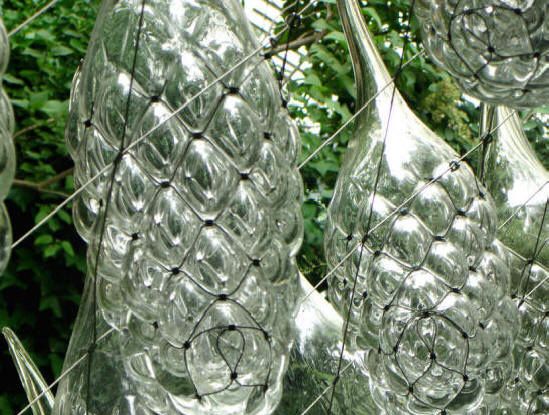
Image by R&Sie(n), Paris, 2008-2009 / I'm Lost In Paris, Blow-glass tube. The ferns receive water from the hydroponic system made of blow-glass tube.
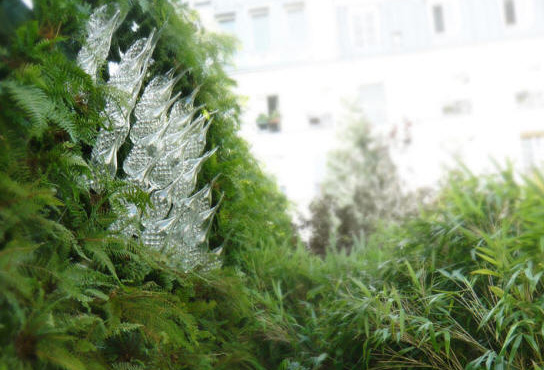
Image by R&Sie(n), Paris, 2008-2009 / I'm Lost In Paris, Ferns. A detail of the ferns that will grow up thanks to the nutrition from the blow-glass tube of water.
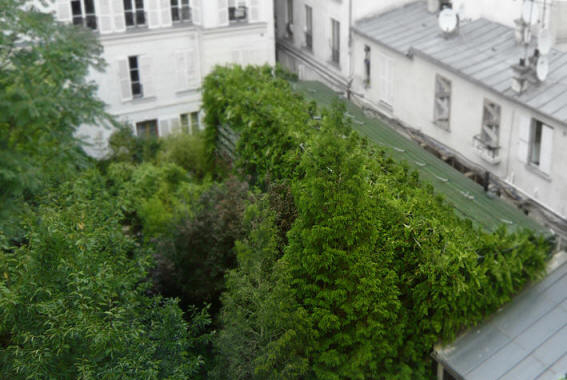
Image by R&Sie(n), Paris, 2008-2009 / I'm Lost In Paris, Aerial view of house with the ferns that grow around the house.
The choice of this plant, the fern, is strategic. As we know, there is a strong relationship between a mass of plant form and its lifespan. Big plants live longer than small ones, as noted Michael Weinstock.
A similar project is Spider Net in the Wood, that R&Sie(n) constructed in 2007 at Nîmes (France), confirm Michael Weinstock’s assertion. The scenario is clear and simple: «Over density of existing forest plantation (trees will be at the right level in 5 years)...» R&Sie(n) has posted a series of pictures of the evolution of the plant one year after the construction, entitled Growing plants. As we can see, plants, gradually, seem to absorb the house. The structure is made of netting and wrapping the forecasted size of adult trees with a polypropylene mesh in order to develop a labyrinth in the branches. The house consists of stealth indoor 400 m2 summer 2-stories building that has been plugged and connected to the labyrinth by a huge sliding glass door.
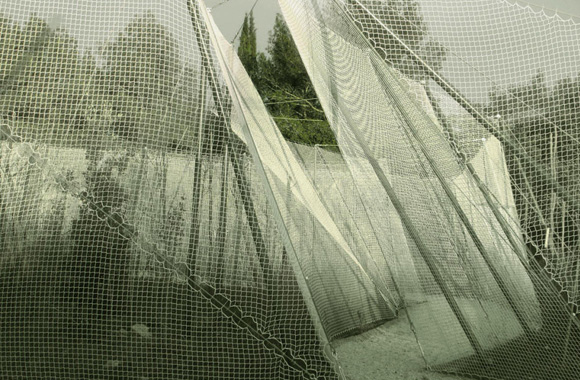
Image by R&Sie(n), Nîmes, 2007 / Spider net in the Wood, Detail of the net.
This house functions as the principle of plants: it is unpredictable, if not to say, self-organizational. It aims at demonstrating that building as well as plants is capable of being changed in response to local or global stresses. This house is a prototype of François Roche and Stéphanie Lavaux’s interest for biomimetics, biomimetics or else the behavior of building stressed by nature, to summarize simply (the same Michael Weinstock wrote this: «[...] abstracting principles from the way in which biological processes develop a natural material system, applying analogous methods in an industrial context, and using stronger materials to manufacture a material that has no natural analogue.»). The plan of the house shows the relationship of the building and its surrounding environment.
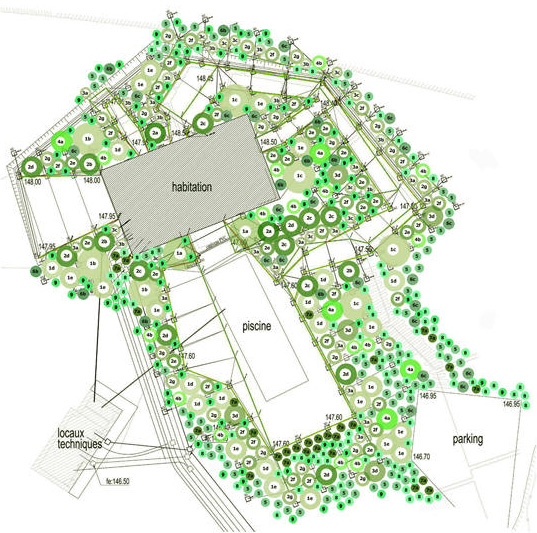
Image by R&Sie(n), Nîmes, 2007 / Spider net in the Wood, plan of the house and its surrounding environment.
Nature will gradually control the building the building, as I wrote above, will, gradually, be absorbed by its surrounding environment.

Image by R&Sie(n), Nîmes, 2007 / Spider net in the Wood, One year after: view of the house and its surrounding environment.

Image by R&Sie(n), Nîmes, 2007 / Spider net in the Wood, one year after: view of the pool.
What I find fascinating here is the concept of adaptive: in R&Sie(n)’s architectural projects, the building functions as the plants, meaning: it is adaptive. It will be obliged to manage its behavior facing the plants as the plants will resist to this structure made of various technologies and techniques. Plants as well as buildings function in the same way. Precisely, building needs to capture light, ventilation as well as it will exchange gases such as metabolic structures. This is what François Roche and Stéphanie Lavaux call Uncertainties, a research that they have been undertaking since 2005 (since their exhibition I’ve Head about). It is very instructive not only for architects but for engineers who work on ecological architecture and urbanism.
Michael Weinstock discussed the concept of redundancy that can be easily used here (Spider Net in the Wood), there (I’m Lost In Paris), and there again (Mosquito). Redundancy, in a biological meaning, as Michael Weinstock wrote, is «not only that the system has more cells available in each tissue than any single task would require, but also that the hierarchical organization of cells is arranged so that issue has sufficient excess capacity for adaptation to changing environmental stresses» while in Engineering, redundancy is considered as an opposition «to efficiency». The distinction, he noted, is that this concept is important if not to say crucial for biology «without which adaptation and response to changing environmental pressures would be possible».
Now I would like to finish this short post with the use of modeling and scripts, and their value in understanding the behavior of nature, and its interaction with urban structure.
Analyzing pictures, plans, diagrams of R&Sie(n)’s projects teaches us the complexity of the process of their work. Let’s take, for instance, the project Mosquito Bottleneck, a house project built in 2003 for an art collector in Trinidad. Precisely, the illustration that shows the movement of the mosquito. This movement produces a simple form that, then, will be assembled to form a complex structure that have behaviors which, in turn, will self-assembled into a more complex structure, and so forth.

Image by R&Sie(n), Trinidad 2003 / Mosquito Bottleneck, Sketch of the mosquito. Study of the movement of the mosquito.
These descriptions and digital models, as I mentioned above, permit a better understanding of the structural performance not only of the biological structure (here: the mosquito, there: surrounding environment, there again: the ferns) but also the building. In the case of Mosquito Bottleneck, the analysis of the movement of the mosquito turned into a klein-bottle twist between the two contradictory data: that of humans and that of insects.
It is interesting to note that the architects used a fragile structure and materials for this building as if they wanted to simulate the fragility of the mosquito lifespan... and our fragility facing with the Mosquito-borne West Nil Fever virus... The skin of the building consists of plastic wire and plastic shrink-warp to weave together the house from the floor to the roof. The goal was to build a skin that would actually attract mosquitoes and move them through the building, while, of course, keeping them separate from the occupants. The result is: the dwelling structure behaves like the mosquitoes as it vibrates like the buzzing of the mosquitoes.

Image by R&Sie(n), Trinidad 2003 / Mosquito Bottleneck, detail of the skin of the house.
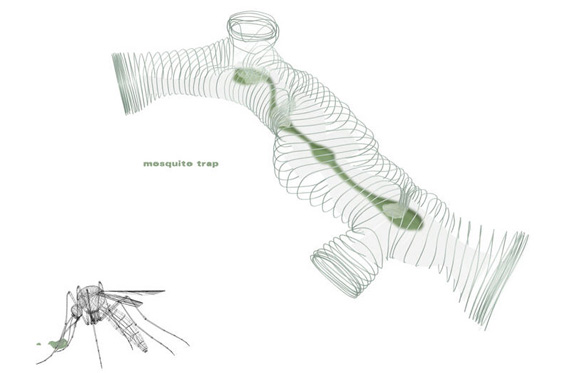
Image by R&Sie(n), Trinidad 2003 / Mosquito Bottleneck, diagram of the bottle-klein house. Mosquito trap.
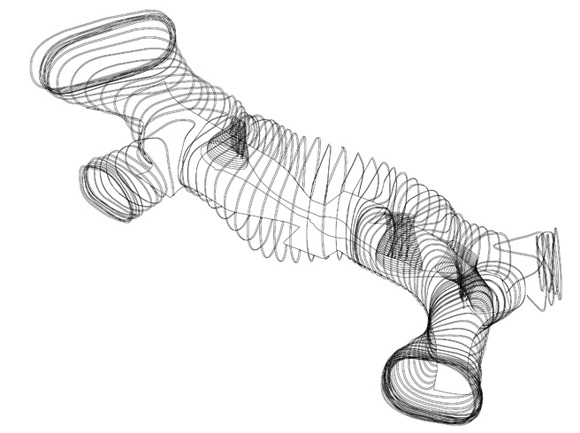
Image by R&Sie(n), Trinidad 2003 / Mosquito Bottleneck, diagram of the Bottle-klein house.
Digital models facilitate the construction of these projects Mosquito Bottleneck, Spider in the Wood, I’m Lost In Paris as well as previous and forthcoming projects. It enables analysis and simulations. The natural behavior of the mosquito is then shifted into a structural behavior that will be modeled, then, scripted with the use of softwares from 3D softwares to mathematical softwares. The analysis of natural environment leads to the construction of house that will be progressively controlled by nature. Conversely, the intrusion of nature (the ferns) in an urban environment (Haussmanian buildings) has previously been simulated with advanced tools in order to draw various scenarios of relationship and conflict between nature, urban environment and humans, etc.
In conclusion (temporarily), these tools permit to test, simulate at various scale behaviors, scenarios, etc., that, will, then, be reinterpreted into construction, meaning, architecture and engineering. They reveal an agenda for new strategies not only in terms of design but also in terms of construction, that is, new system for advanced architectural engineering. If one wonders what ecology can bring to architecture, first answers can be found in projects such as R&Sie(n)’s ones.
Bibliographies R&Sie(n), www.new-territories.com
Roche François, «[Science]Fiction & Mass culture Crisis», in R&Sie(n), DD 05 R&Sie:Corrupted Biotopes, Damdi, 2005, pp.6-17.
Corbellini Giovanni, Bioboot: The Architecture of R&Sie(n), Princeton Architectural Press, 2010.
Gissen David, Subnature: Architecture’s Other Environment, Princeton Architectural Press, 2009.
Weinstock Michael, «Self-Organisation and structural dynamic of plants», in Hansel Michael, Menges Achim, Weinstock Michael (Guest editors), Techniques and Technologies in Morphogenetic design, Architectural design, March 2006, pp.26-33;
Weinstock Michael, «Self-Organisation and material construction», in Hansel Michael, Menges Achim, Weinstock Michael (Guest editors), Techniques and Technologies in Morphogenetic design, Architectural Design, March 2006, pp.34-41.
Weinstock Michael, «Metabolism and Morphology», in Hansel Michael, Menges Achim (Guest editors), Versality and Vicissitude: Performance in Morpho-Ecological Design, Architectural Design, March 2008, pp.27-33.
Arbona Javier, «It’s in your nature I’m lost in Paris», Gissen David (Guest editor), Territory, Architectural Design, May 2010, pp.46-53.
See also Lally Sean (Guest editor), Energies: New Material Boundaries, in Architectural design, April 2009, in particular Michelle Addington’s text Contingent Behaviours, Mathieu Lehanneur’s text Domestic Micro-Environments.
Hensel Michael, Menges Achim, Weinstock Michael (Gest editors), Emergence: Morphogenetic Design Strategies, May 2004, in particular, Michael Weinstock’s Morphogenesis and the Mathematics of Emergence, Achim Menges’s Morpho-Ecologies: Approaching Complex Environments, George Jeronimidis’s Biodynamics.
This Guest post by Annick Labeca forms part of the discussion in the single-blogs series on Ecological Urbanism.
---
Annick Labeca is a researcher on Japanese cities based between Paris and Tôkyô. She has a deep interest on typomorphology and morphogenetic architecture.

Tidak ada komentar:
Posting Komentar